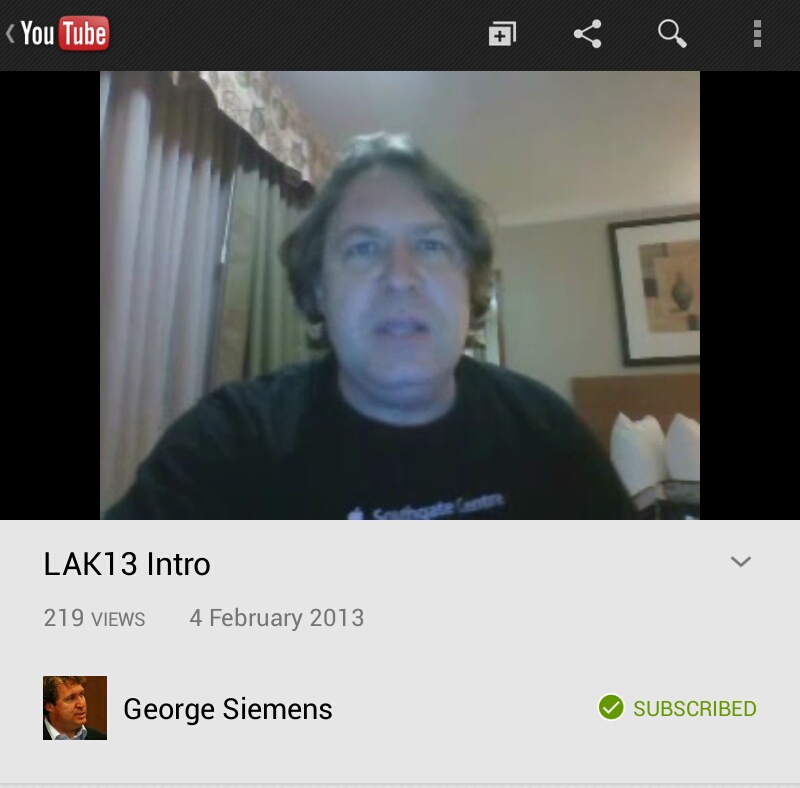Reading Time: 3 minutes

So, here I am on the Learning Analytics and Knowledge MOOC again, or LAK13 to use its abbreviated name. It is one full year since I aborted LAK12 and 18 months since I aborted the famed Stanford AI MOOC. Determined not be a perennial MOOC dropout I have decided to have another crack of the whip. Not that being a MOOC dropout is necessarily a bad thing, at least not in my book although the MOOC bashers will no doubt beg to differ. People will enter into open courses for many reasons and the success of a MOOC shouldn’t be determined by the number of finishers. I gained a lot from LAK12 in the limited time I was on it and it gave me a great primer on learning analytics which has been really useful in my work over the past year.
Now I’m ready for more of a deep dive though. It’s more than a personal interest, we are starting to work at Epic with Tin Can API, which provides a standard for tracking data about learning activities from multiple different systems. While there is a need to strike a balance between collecting too little or too much data, the fact remains that we will end up with an extremely large data set about the learning experiences and performance of our learners. I have been studying Tin Can API for some months now and feel that I understand it well. The next challenge is to understand how to analyse and present that data which is where this MOOC comes in. I hope it will give me some tools and techniques for doing so.
One of the first pieces of reading material on Week One was an article titled “Penetrating the Fog: Analytics in Learning and Education” from EDUCAUSE Review. This article by George Siemens is a primer on learning analytics. A clear distinction is made between learning analytics and academic analytics:
- Learning analytics is concerned with understanding and optimising learning and the environments in which it occurs, and operates at course and departmental level.
- Academic analytics applies business intelligence in an education context and operates at institutional, regional, national and international level.
The lectures in LAK13 have been pretty focused on the education sector so I need to translate this into a workplace learning environment which is the focus of my own work. It seems that learning analytics will be the domain of the learning and development professional who probably operates within a large department and maybe at organisational level but whose focus remains more at individual level and on course design. Organisation-wide analysis at region, country or international level will more likely be the domain of the HR professional. This kind of separation would account for the rise of HR analytics applications such as those sold by Oracle and Successfactors which operate at this higher level and are more concerned with trends across the business than with individual learners or course design.
Within the learning analytics domain, Siemens suggests a hierarchy framework to help position your learning analytics initiative.
- Course-level: this is the starting level in the hierarchy and looks at learning trails, social network analysis and discourse analysis, this is learning analytics at its most basic and an example would be a learning management system analytics tool.
- Educational data-mining: This is the next level and is concerned with predictive modeling, clustering and pattern mining, focusing on identifying patterns of success at departmental level.
- Intelligent curriculum: this is the development of curricular resources mapped against a specific knowledge domain. Assessment is performed almost constantly and content is provided on the fly in response to the learner’s profile, learning goals and the knowledge domain.
- Adaptive content: this takes things a step further and aims to deliver an adaptive sequence of content based on learner behavior and recommender systems. Applications such as Knewton operate in this space.
- Adaptive learning: so I guess this is the holy grail of learning analytics, and it relates to an adaptive learning process, which includes adapting social interactions, learning activity and learner support, not just content.
So that’s my first reflection on the LAK13 materials I’ve looked at so far. I have some project work that will enable me to really get my teeth into this, and while I won’t be able to blog about the actual customer-led work, I certainly aim to continue blogging about my experiences with analytics tools and techniques. I’m not sure whether I’d put a bet on me staying in the MOOC though, I may end up getting what I need and running, which will be just fine and a perfectly valid MOOC experience. But I do hope to make it to the end. We will see!